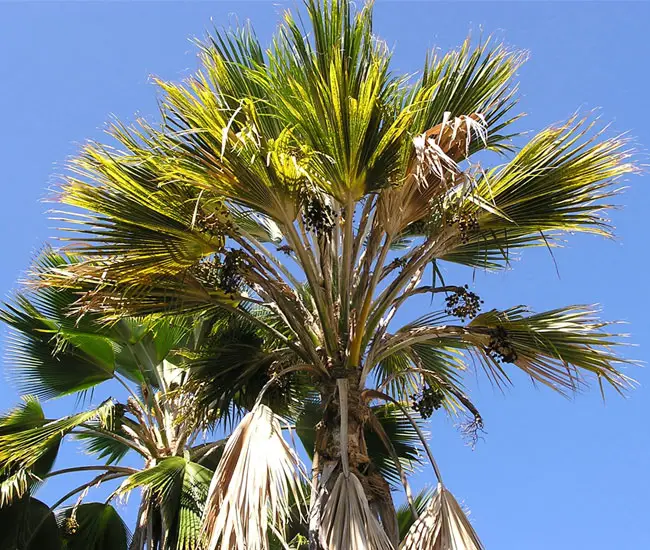
Healthy outdoor palm trees usually establish quickly, are easy to grow, and have very few problems. While it’s normal for the palm to shed old brown fronds, if you notice a lot of brown, yellow, or drooping leaves, there is an issue. Figuring out why your palm tree is sick, could be a challenge.
From my experience of many years growing palm trees, the most common problems are: overwatering, underwatering, nutrient deficiency, disease, insect attack, fertilizer burn, or cold damage. A newly planted palm could have brown or yellow fronds/tips because of a “transplant shock”.
First of all, don’t panic.
There could be a number of reasons why your palm is not feeling well. Most likely it’s one of the basic everyday care issues that is easy to fix. Go through the topics below, and see if one of them applies.
1. Natural Browning
As I’ve mentioned above, it’s normal for the palm to shed bottom fronds since they are being replaced with the new ones that emerge from the middle of the crown.
The old leaves turn brown, dry out, and die dropping to the ground or keep hanging until removed. Each type of palm has its own specific number of fronds that it keeps green.
2. Over-watering
It’s important to know what type of palm you have since different palm species have different water requirements. The first sign of over-watering is yellow or brown leaves that fall before drying.
Unless you have a wrong watering schedule, over-watering usually happens during periods of frequent rains or due to poor drainage. This could cause a root rot which is a fungi that exists in places with excessive moisture.
To solve this problem, improve the drainage by adding sand to the soil or by installing a pipe that will take water away from the plant.
3. Underwatering
Browning of the tips is the first sign that your palm is not getting enough water. Palms like moist but well-drained soil. You can use your fingers or a moisture meter to measure soil moisture levels.
Never let the soil to dry out completely. During the drought season, deep water your palm to make sure the roots have enough time to absorb the water.
Deep watering is when you slowly drip the water instead of dumping it all at once. This method usually works best for newly planted palms that don’t have an extensive root system.
4. Nutrient Deficiency
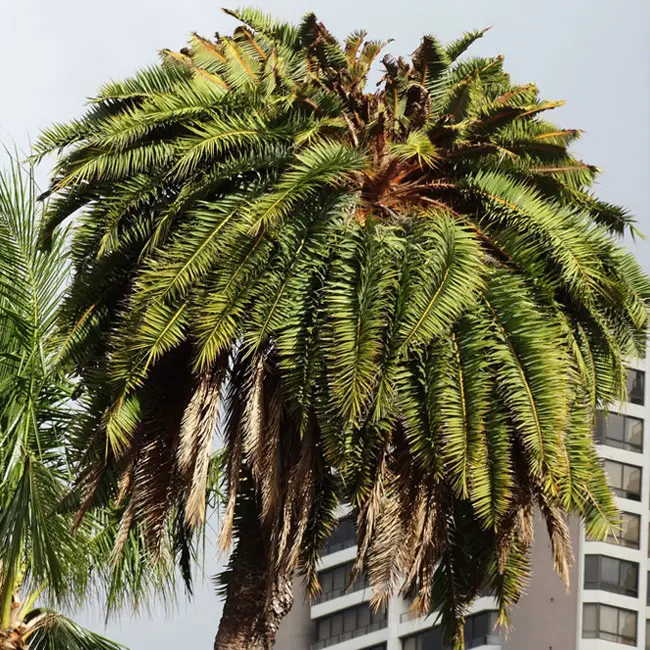
If the water level is not a problem, I would look at the nutrients next. As you know, the most important elements for palms are Nitrogen (N), Phosphate (P), Potassium (K) Magnesium (Mg), Manganese (Mn), and Iron (Fe).
According to University of Florida research, the only way to determine nutrient deficiencies is by visually analyzing the leaf of the palm which could be very difficult if the mineral deficiency overlap. BTW, the soil analysis does not reflect palm nutrient balance so testing soil is pointless.
- In case of Nitrogen (N) deficiency, you will notice abnormally yellow-greenish fronds.
- In case of Potassium (K) deficiency, there will be yellow spotting on older leaves.
- In Magnesium (Mg) deficiency, the tips become bright yellow.
- Manganese (Mn) deficiency causes “frizzletop” deformed new leaves with brown areas.
- During Iron (Fe) deficiency, you will notice that the new leaves are turning yellowish with green veining.
Palm trees should be fertilized during the growing season (end of March through the end of October) with a slow-release good-quality fertilizer. The frequency of palm fertilization greatly depends on the soil type and the amount of rain you get in your region.
5. Cold Damage
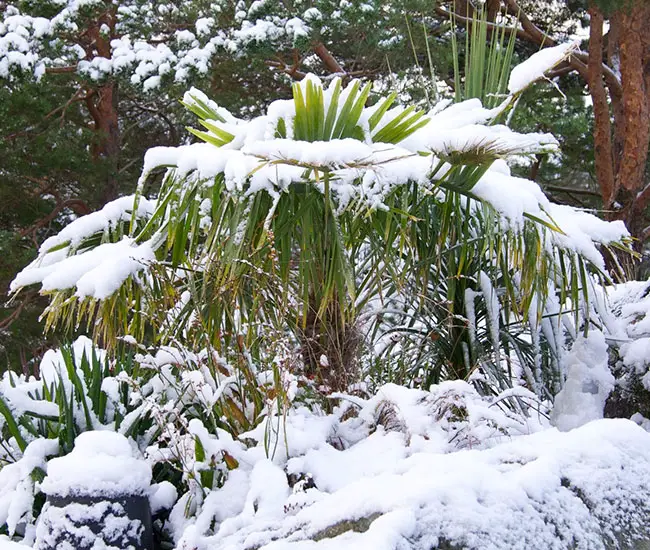
With unexpected cold snaps, sometimes it’s hard to provide timely winter protection. If your palm has been damaged by freeze or cold temperatures, you will notice drooping, wilting, or browning of the old leaves. In some severe cases, the new growth might turn brown, black, or emerge deformed.
It might take months before the damage becomes apparent. There is not much you can do except protect your palm from future cold snaps and apply the anti-bacterial spray to prevent fungi/bacteria from developing.
6. Fertilizer Burn
Too much fertilizer can burn the roots resulting in browning of the tips and fronds. If the fertilizer is placed too close to the trunk it can also burn the trunk. This can seriously weaken the palm inviting insects and diseases.
Fertilize palms only during the growing season with slow-release good-quality fertilizer. Make sure to place 2 ft away from the trunk. If you notice trunk damage, spray the area with anti-bacterial/fungi spray.
7. Transplant shock
It’s normal for newly planted palms to experience a “transplant shock” due to loss of roots, loss of water, new light levels, new temperatures, and new humidity levels. So don’t be surprised to see your newly planted palm turning brown or yellow.
If you planted it the right way, providing good drainage and soil, it should recover pretty soon. You really don’t need to do anything. Don’t fertilize it for the first 2 months while it’s establishing at the new location.
8. Sunburn
Before planting a new palm in full sun, you should acclimate it for a few weeks at the new spot to avoid sunburn. Otherwise, high light levels will cause the fronds to turn yellow and colorless.
To acclimate the palm, place it in a shady spot and gradually increase light levels every week. If the palm is not very tall, you can cover it with plastic increasing light levels each week by making more holes in the plastic.
If your palm got sunburned, leave the damaged fronds on the tree. Your palm will get used to the new environment and will recover after a few months.
9. Insect Attack
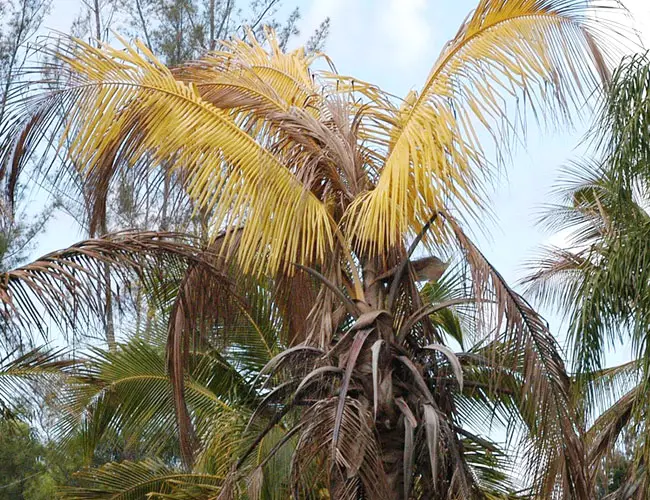
Healthy palms naturally resist insects and diseases but can get attacked if they are under stress. The most common attackers are scale, spider mite, and mealy bugs.
Thankfully, insect pests are more of a nuisance than a severe problem on palms. They cause little harm to palms and the palm usually outgrows any damage.
You will need to expect the leaves to see if you can spot the insects. Get rid of the pests by spraying them with insecticidal soap.
10. Diseases
Various fungi cause the most common diseases of palm. Ganoderma butt rot and fusarium wilt is among them. With fusarium wilt, the leaflets on only one side of the leaf stem of the oldest leaves turn brown.
Then a reddish or dark brown stripe develops along the leaf stem. Both Ganoderma butt rot and fusarium wilt have no treatment.
Another serious disease is lethal yellowing, which causes leaves to turn yellow, grey, or brown starting with the old fronds and then moving to the new leaves.
There are also several leaf spot fungi that cause yellow or dark brown spotting on leaflets. But they mostly develop on palm trees that are under stress. Eliminating the cause of stress can solve the problem. Also, the application of fungicidal sprays containing copper hydroxide or copper salts of fatty acids can help.
Why Is My Newly Planted Palm Tree Is Turning Brown
I did mention above that newly planted palms can experience a ‘transplant shock’. Transplant shock is caused due to roots being disturbed and exposed to air. During transplanting your palm will lose a lot of the roots resulting in water stress.
Also, it will need time to adjust to the new soil, light, and humidity levels. So, it is not unusual for the newly planted palm to turn yellow or brown or have droopy leaves. While there is no way to prevent transplant shock, there are ways to minimize it by acclimating the palm to the new location.
You can acclimate the palm over a few weeks, by placing the pot in the new location and by gradually increasing light levels. Also, when placing the palm into the soil, try to disturb the root ball as little as possible. There is no need for old soil removal.
You should water it daily for the first week, every other day for the second, and then you can switch to its regular schedule. Deep watering works the best! Avoid fertilizing the palm for the first two months. If you follow my planting instructions, your palm will experience minimum transplant shock.
Should I Cut Off Brown Palm Leaves
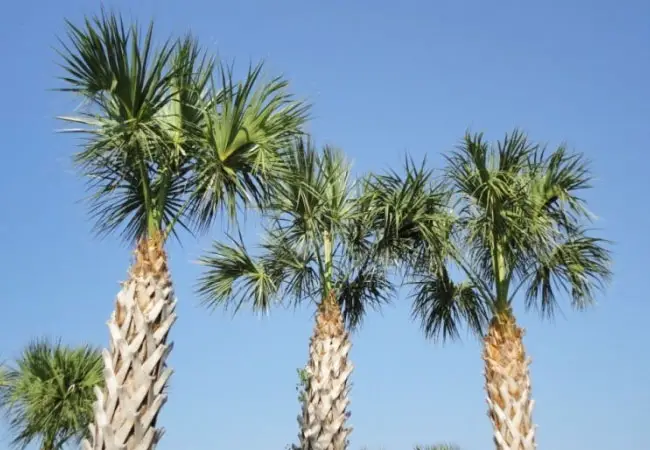
There are many articles online that tell people to cut off brown tips or leaves because it will save the palm tree from wasting nutrients on the dying leaf. Makes sense right? Wrong!
Palm trees need old leaves for nutrients, and when you cut them off, your palm gets stressed because palms move nutrients, especially potassium (K), from the older fronds to the new growth.
Not all palms need to be pruned. Palms with crownshafts, a smooth area at the top of the trunk created by tightly clasping leaf bases, should never be pruned since they drop old brown leaves naturally. They called ‘self-cleaning’ palms.
A leaf will be green one day, completely orange-brown the next day, and completely brown on the third day, when it should fall off on its own. That is a natural cycle.
Palm without crownshaft have a very similar cycle, but the dead leaves hang against the trunk and might need to be cut or pulled off manually. Prune them off ONLY when they are completely brown and dry.
When pruning the fronds, cut as close as possible to the trunk, and do NOT remove any fronds that grow at a 45-degree angle or greater. If your palm tree looks like a rooster’s tail, you over-pruned it.
BTW, according to University of Florida research, the removal of palm flowers or fruits results in an increased leaf production rate.
If You Cut Palm Tree In Half Will It Grow Back?
Some gardeners think that cutting palm trees in half will promote better root development and ultimately strengthen the palm. However, this is not the case.
If you cut a palm tree’s trunk in half, it will not grow back. Instead, it will die. Palms are unable to heal themselves when their trunk is injured.
The growing point of the palm called the bud or the heart, is located near the top of the trunk and ties in with the vascular system. If you cut off the heart, the palm will die because it cannot produce another one.
Can Brown Palm Leaves Turn Green Again?
Although you can bring your dying palm tree back to life, brown or yellow leaves will NEVER turn green again. You will have to wait for the palm to renew its crown to get rid of the damaged fronds. As I explained above, you can remove brown leaves only when they are completely dry.
Also, keep your eye on the new growth that emerges from the bud, also known as the ‘heart’ of the palm. If it looks healthy and green, the problem is solved. If the tips of the newly emerging fronds are starting to turn brown, the issue remains.
While there is nothing you can do to about brown leaves, drooping leaves will become upright again once the problem is solved.
Why Are Majesty Palm Leaves Turning Brown
Majesty Palm (Ravenea rivularis) is a popular palm that is native to Madagascar, a large island in the Indian Ocean off the eastern coast of southern Africa, east of Mozambique. There it grows in moist areas like river banks and humid valleys.
To reach its full potential, it needs plenty of water, good drainage, and a lot of fertilizer. Lack of nitrogen will result in yellow leaves. It also likes full sun or partial shade. Underwatering or overwatering can cause brown tips/leaves.
It is also widely used as an indoor palm because of its small size. One of the common problems of growing it indoors is its need for humidity. Dry air will also cause tips to start turning brown.
If your Majesty palm is turning brown or yellow, start by inspecting basic everyday care. See if you can provide it with an environment as close to the natural habitat as possible. Since Ravenea rivularis likes warm weather, protect it from sudden cold snaps.
Why My Areca Palm Tree Has Brown Tips and Yellow Spots
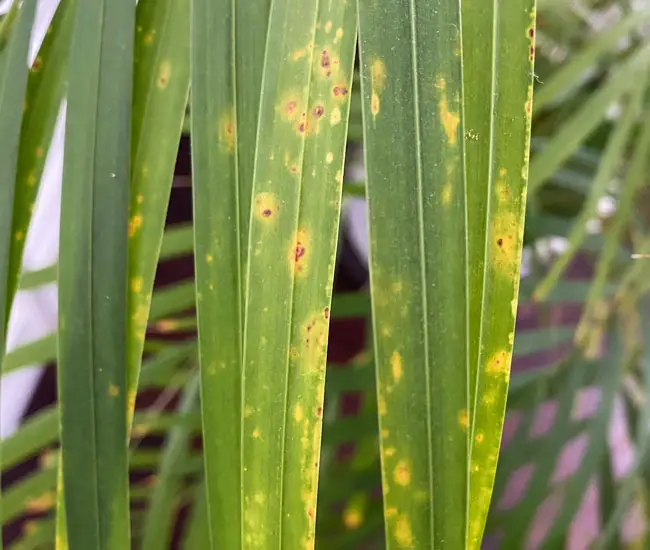
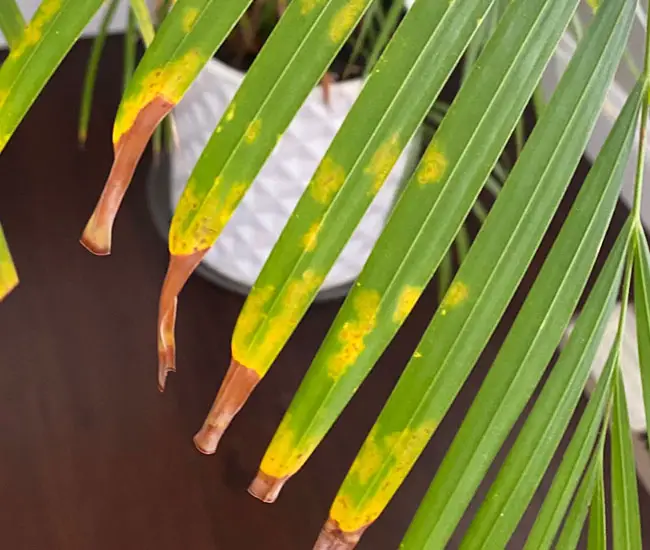
If your indoor Areca palm looks like the one in the picture above, it has multiple overlapping problems. The brown tips are a result of under-watering and low humidity.
The yellow and brown spots are a sign of Potassium and possibly Magnesium deficiency. The deficiency is not very severe, because there are no black spots yet.
How do I know? Well, this Areca palm has been at my mom’s house for the last 7 years. So I know she forgets to water it regularly. It is also positioned right next to the floor vent that blows hot air directly on the plant.
In addition, she has NEVER fertilized the palm, and it has been only recently transplanted it into a bigger container. All I can say is that Areca palm is a very tough indoor plant. LOL. BTW, I took it into my house and will try to restore its beauty.
Pictures Of Sick Palm Tree Leaves
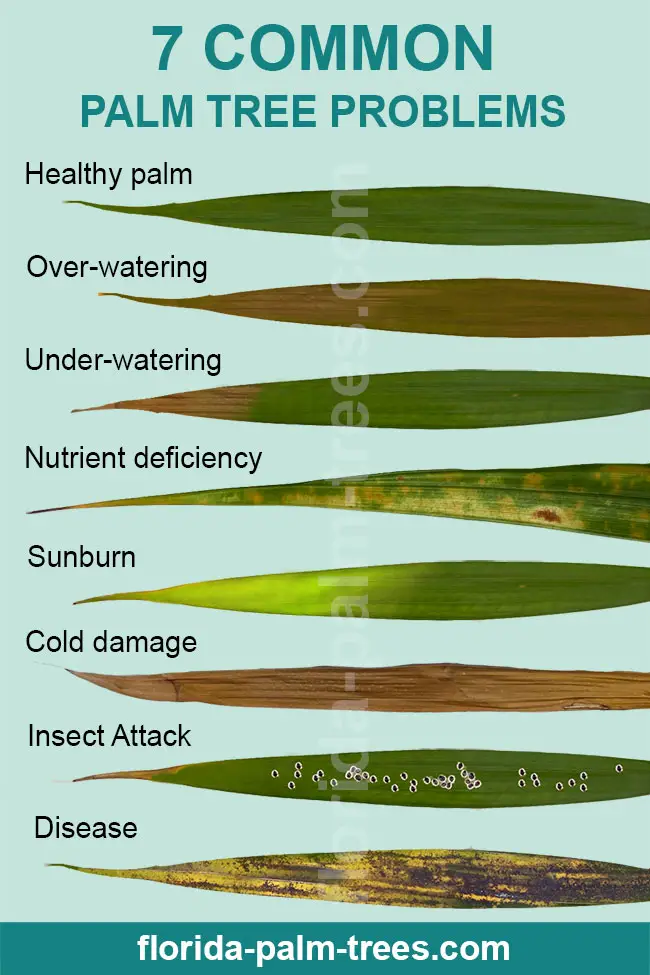
Conclusion
As you can see, an established palm tree will have different problems than a newly planted one. Mature palms do not have acclimatization problems like new soil, humidity, or light levels. It’s been growing in this location for a while and is used to the environment.
Also, the watering and drainage issues have already been resolved. That being said, if you established palm turning brown or yellow it’s most likely nutrient deficiency or cold damage.
Related articles:
–Top 10 Palm Tree Care Mistakes and How To Avoid Them
–Top 10 Palm Tree Planting Mistakes You Don’t Want To Make
–5 Most Common Nutrient Deficiencies In Palms (with Pictures)
–Expert Tips: How And When To Fertilize Palm Trees
–5 Steps To Saving Freeze Damaged Palm Tree
